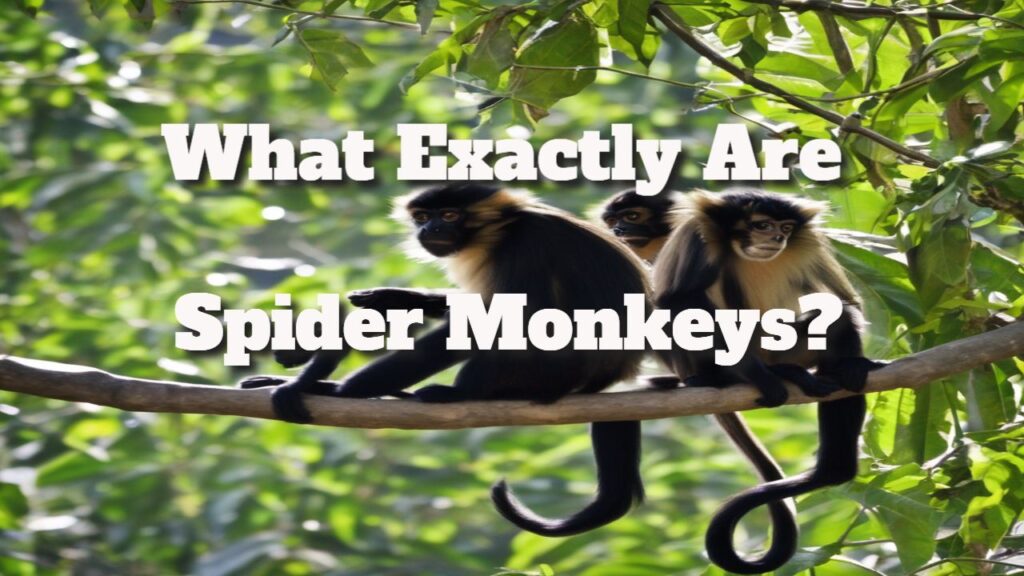What Exactly Are Spider Monkeys?
Spider monkeys are massive New World monkeys from central Mexico to Bolivia in tropical jungles.
These agile monkeys come in seven different varieties. Their name comes from how their long limbs and tails dangle from branches and swing across the treetops.
Four long fingers on each hand also help them hold trees. (They have thumbs as well, but they are incredibly short).
These swingers move around by brachiation or moving from tree to tree.
The spider monkey's tail is prehensile, which means “capable of grasping”. It is usually longer than the animal's body and is a fifth limb, allowing it to adapt to life in the treetops.
It can support the spider monkey's total body weight and helps it to climb, forage, and eat while clinging to branches.
Although the seven spider monkey species share several physical characteristics and behaviours, they differ in geographic range and appearance.
The coat of white-bellied spider monkeys is black to chestnut brown with a pale spot on the forehead and a white-beige hair stripe from the chin to the abdomen. They can be found all the way from Colombia to Peru.
Red-faced spider monkeys are clothed in silky black hair save for their bare cheeks, hands, and feet.
Nutrition and Behaviour
These species typically consume fruits but also leaves, nuts, seeds, and, on occasion, arachnids and insects.
Spider monkeys are essential seed dispersers in their rainforest habitat. When animals consume the fruits and nuts from the trees and then leave, they leave seeds behind, allowing the tree species to spread over the area.
In tropical forests, animals disseminate between 50 and 90 percent of the seeds.
Spider monkeys are social species who live in groups of up to 40. This group's smaller subgroups frequently break off to forage for food.
Males spend more time eating and relaxing, while females spend more time eating ripe fruit and moving, according to a 2014 study on Mexican spider monkeys in Belize.
Males are more mobile since they patrol their borders and raid other forces before returning to check on their ladies.
Breeding
Male and female spider monkeys are known to have multiple sexual partners, but their reproductive behaviour is challenging to document, even in captivity, and was not even seen until the 1970s.
Males must struggle to find and mate with the few receptive females in a single mating season, according to a 2010 study of the black-faced spider monkey.
The majority of contacts were also discovered to take place in private. Like other primates, Spider monkeys form partnerships in which males and females join forces and leave the group for a few days.
Spider monkeys have a seven to 7.5-month gestation period. A single spider monkey will wait two to four years before giving birth again, even though they do not have a single reproductive season.
Except for the exposed skin surrounding their “baby face” eyes, the newborns are entirely hairless. Most helpless babies cling to their mothers, who take over parental care after two years and wean them.
Conservation of Species
According to the International Union for the Conservation of Nature (IUCN), all spider monkey populations are declining.
The Guyana spider monkey resides in Guyana, French Guiana, Suriname, and Brazil, is the most stable natural population and is on the verge of extinction.
Even though much of it is protected, agricultural, cattle and road construction are destroying the monkeys' habitat.
The brown spider monkey is found in Colombia and Venezuela, and its population is the least stable.
These animals are threatened, which means they are only two steps away from extinction.
They are a popular target for hunters, who shoot them for fun and to manufacture treatments for ailments like rheumatism and snakebites.
In addition, their wooded habitat is being destroyed to make way for livestock, agriculture, logging, and human development.
Only around 20% of the species' historic range remains, and the remaining wooded portions may be unsustainable.
There has been some conservation activity for the species, including local awareness campaigns in Venezuela and ongoing investigations to identify species and forests that may be conserved in Colombia.
Other spider monkey species are also threatened by habitat loss caused by humans.
The Central American spider monkey's diet consists primarily of fruit commonly found in diminishing woods.
Another hazard to this monkey species is the illegal drug trade.
Drug traffickers clear enormous expanses of forest for cattle ranching or other money-laundering operations, claiming 20 to 60% of the original habitat of this monkey, which stretches from Mexico to Panama.
According to the International Primatological Society's 2019 Primates in Peril report, the species is among the world's 25 most endangered primates.
The post What Exactly Are Spider Monkeys? appeared first on https://gqcentral.co.uk
The Article What Exactly Are Spider Monkeys? First Appeared ON
: https://ad4sc.com







Comments are closed